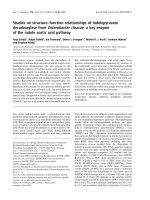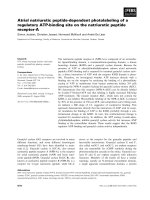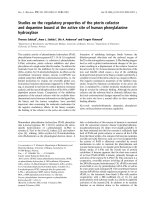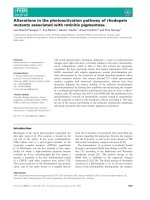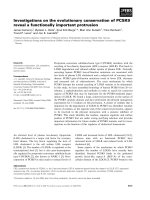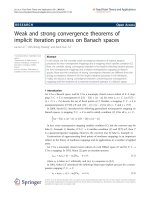Báo cáo toán học: "Note on generating all subsets of a finite set with disjoint union" potx
Bạn đang xem bản rút gọn của tài liệu. Xem và tải ngay bản đầy đủ của tài liệu tại đây (103.96 KB, 6 trang )
Note on generating all subsets of a finite set
with disjoint unions
David Ellis
e-mail:
Submitted: Dec 2, 2008; Accepted: May 12, 2009; Published: May 20, 2009
Mathematics Subject Classification: 05D05
Abstract
We call a family G ⊂ P[n] a k-generator of P[n] if every x ⊂ [n] can b e expressed
as a union of at most k disjoint sets in G. Frein, L´evˆeque and Seb˝o [1] conjectured
that for any n ≥ k, such a family must be at least as large as the k-generator
obtained by taking a partition of [n] into classes of sizes as equal as possible, and
taking the union of the power-sets of the classes. We generalize a th eorem of Alon
and Frankl [2] in order to show that for fixed k, any k-generator of P[n] must have
size at least k2
n/k
(1 − o(1)), thereby verifying the conjecture asymp totically for
multiples of k.
1 Introduction
We call a family G ⊂ P[n] a k-generator of P[n] if every x ⊂ [n] can be expressed as a
union of at most k disjoint sets in G. Frein, L´evˆeque and Seb˝o [1] conjectured that for
any n ≥ k, such a family must be at least as large as the k-generator
F
n,k
:=
k
i=1
PV
i
\ {∅} (1)
where (V
i
) is a partitio n of [n] into k classes of sizes as equal as possible. For k = 2,
removing the disjointness condition yields the stronger conjecture of Erd˝os – namely, if
G ⊂ P[n] is a family such that any subset of [n] is a union (not necessarily disjoint) of at
most two sets in G, then G is at least as large as
F
n,2
= PV
1
∪ PV
2
\ {∅} (2)
where (V
1
, V
2
) is a partition o f [n] into two classes of sizes ⌊n/2⌋ and ⌈n/2⌉. We refer the
reader to for example F¨uredi and Katona [5] f or some results around the Erd˝os conjecture.
In fact, Frein, L´evˆeque and Seb˝o [1] made the analagous conjecture for all k. (We call a
the electronic journal of combinatorics 16 (2009), #N16 1
family G ⊂ P[n] a k-base of P[n] if every x ⊂ [n] can be expressed as a union of at most
k sets in G; they conjectured that for any k ≤ n, any k-base of P[n] is at least as large a s
F
n,k
.)
In this paper, we show that for k fixed, a k-generator must have size at least k2
n/k
(1−
o(1)); when n is a multiple of k, this is asymptotic to f(n, k) = |F
n,k
| = k(2
n/k
−1). Our
main tool is a generalization of a theorem of Alon and Frankl, proved via an Erd˝os-Stone
type result.
As observed in [1 ], for a k-generator G, we have the following trivial bound on | G| = m.
The number of ways of choosing at most k sets in G must be at least the number of subsets
of [n], i.e.:
k
i=0
m
i
≥ 2
n
For fixed k, the number of subsets of [n] of size a t most k −1 is
k−1
i=0
m
i
= Θ(1/m)
m
k
,
so
k
i=0
m
i
= (1 + Θ(1/m))
m
k
= (1 + Θ ( 1/m))m
k
/k!
Hence,
m ≥ (k!)
1/k
2
n/k
(1 −o(1))
Notice that this ig no res disjointness, and is therefore also a lower bound on the size o f a
k-base; it also ignores the fact that some unions may occur several times. We will improve
the constant from (k!)
1/k
≈ k/e to k by taking into account disjointness. Namely, we will
show that for any fixed k ∈ N and δ > 0, if m ≥ 2
(1/(k+1)+δ)n
, then a ny fa mily G ⊂ P[n]
of size m contains at most
k!
k
k
+ o(1)
m
k
unordered k-tuples {A
1
, . . . , A
k
} of pairwise disjoint sets, where the o(1) = o
k,δ
(1) term
tends to 0 as m → ∞ for fixed k, δ. In other words, if we consider the ‘Kneser graph’ on
P[n], with edge set consisting of the disjoint pairs of subsets, the density of K
k
’s in any
sufficiently large G ⊂ P[n] is at most k!/k
k
+ o(1). The proof uses an Erd˝os-Stone type
result (Theorem 1) together with a result of Alon and Frankl (Lemma 4, which is Lemma
4.3 in [2]).
The k = 2 case o f this was proved by Alon and Frankl (Theorem 1.3 of [2]): for any
fixed δ > 0, if m ≥ 2
(1/3+δ)n
, then any family G ⊂ P[n] of size m contains at most
1
2
+ o(1)
m
2
disjoint pairs, where the o(1) term tends to 0 as m → ∞ for fixed δ. In other words, the
edge-density in any sufficiently larg e subset of the Kneser graph is at most
1
2
+ o(1).
Our result will follow quickly from this. From the tr ivial bound above, any k-generator
G ⊂ P[n] has size m ≥ 2
n/k
, so putting δ = 1/k(k + 1), we will see that the number of
the electronic journal of combinatorics 16 (2009), #N16 2
unordered k-tuples of pairwise disjoint sets in G is at most
k!
k
k
+ o(1)
m
k
so
2
n
≤
k!
k
k
+ o(1) + Θ(1/m)
m
k
=
m
k
k
(1 + o(1))
and therefore
m ≥ k2
n/k
(1 −o(1))
where the o(1) term tends to 0 as n → ∞ fo r fixed k ∈ N.
For k = 2, this improves the estimate m ≥
√
22
n/2
− 1 in [1] (Theorem 5.3) by a
factor of
√
2. For n even, it is asymptotically tight, but for n odd, the conjectured
smallest 2-generator (2) has size (3/
√
2)2
n/2
− 1, so our constant is ‘out’ by a factor of
3/(2
√
2) = 1.061 (to 3 d.p.)
For general k and n = qk + r, the conjectured smallest k-generator (1) has size
(k − r)2
q
+ r2
q+1
− k = (k + r)2
−r/k
2
n/k
− k
so our constant is out by a factor of (1 + r/k)2
−r/k
≤ 2
1−1/ ln 2
/ ln 2 = 1.061 (to 3 d.p.).
It seems that different arguments will be required to improve the constant for k ∤ n,
or to prove the exact result. Further, it seems likely that proving the same bounds for k-
bases (i.e. without the assumption of disjoint unions) would be much harder, and require
different techniques a ltogether.
2 A preliminary Erd˝os-Stone type result
We will need the following generalization of the Erd˝os-Stone theorem:
Theorem 1 Given r ≤ s ∈ N and ǫ > 0, if n is sufficiently large depending on r, s and
ǫ, then any graph G on n vertices with at least
s(s −1)(s −2) . . . (s −r + 1)
s
r
+ ǫ
n
r
K
r
’s contains a copy of K
s+1
(t), where t ≥ C
r,s,ǫ
log n for som e constant C
r,s,ǫ
depending
on r, s, ǫ.
Note that the density η = η
r,s
:=
s(s−1)(s−2) (s−r+1)
s
r
above is the density of K
r
’s in the
s-partite Tur´an gra ph with classes of size T , K
s
(T ), when T is large.
Proof:
Let G be a graph with K
r
density at least η+ǫ; let N be the number of l-subsets U ⊂ V (G)
the electronic journal of combinatorics 16 (2009), #N16 3
such that G[U] has K
r
-density at least η + ǫ/2 . Then, double counting the number o f
times an l-subset contains a K
r
,
N
l
r
+
n
r
− N
(η + ǫ/2)
l
r
≥ (η + ǫ)
n
r
n −r
l − r
so rearranging,
N ≥
ǫ/2
1 − η − ǫ/2
n
l
≥
ǫ
2
n
l
Hence, there are at least
ǫ
2
n
l
l-sets U such that G[U] has K
r
-density at least η + ǫ/2.
But Erd˝os proved that the number of K
r
’s in a K
s+1
-free graph on l vertices is maximized
by the s-partite Tur´an graph on l vertices (Theorem 3 in [3]), so provided l is chosen
sufficiently large, each such G[U] contains a K
s+1
. Each K
s+1
in G is contained in
n−s−1
l−s−1
l-sets, and therefore G contains at least
ǫ
2
n
l
n−s−1
l−s−1
≥
ǫ
2
(n/l)
s+1
K
s+1
’s, i.e. a positive density of K
s+1
’s. Let a = s + 1, c =
ǫ
2l
s+1
and apply the fo llowing
‘blow up’ theorem of Nikiforov (a slight weakening of Theorem 1 in [4]):
Theorem 2 Let a ≥ 2, c
a
log n ≥ 1. Then any g raph on n vertices with a t least cn
a
K
a
’s
contains a K
a
(t) with t = ⌊c
a
log n⌋.
We see that provided n is sufficiently large depending on r, s and ǫ, G must contain a
K
s+1
(t) for t = ⌊c
s+1
log n⌋ = ⌊(
ǫ
2l
s+1
)
s+1
log n⌋ ≥ C
r,s,ǫ
log n, proving Theorem 1.
3 Density of K
k
’s in large subsets of the Kneser graph
We are now ready for our main result, a generalization of Theorem 1.3 in [2]:
Theorem 3 For any fixed k ∈ N and δ > 0, if m ≥ 2
“
1
k+1
+δ
”
n
, then any family G ⊂ P[n]
of size |G| = m contains at most
k!
k
k
+ o(1)
m
k
unordered k-tuples {A
1
, . . . , A
k
} of pairwise disjoint sets, where the o(1) term tends to 0
as m → ∞ for fixed k, δ.
Proof:
By increasing δ if necessary, we may assume m = 2
“
1
k+1
+δ
”
n
. Consider the subgraph G of
the ‘Kneser graph’ on P[n] induced on the set G, i.e. the graph G with vertex set G and
edge set {xy : x ∩y = ∅}. Let ǫ > 0; we will show that if n is sufficiently large depending
the electronic journal of combinatorics 16 (2009), #N16 4
on k, δ and ǫ, the density of K
k
’s in G is less than
k!
k
k
+ ǫ. Suppose the density of K
k
’s in
G is at least
k!
k
k
+ ǫ; we will obtain a contradiction for n sufficiently large. Let l = m
f
(we
will choo se f <
δ
2(1+(k+1)δ)
maximal such that m
f
is an integer). By the argument above,
there are at least
ǫ
2
m
l
l-sets U such that G[U] has K
k
-density at least
k!
k
k
+
ǫ
2
. Provided
m is sufficiently large depending on k, δ and ǫ, by Theorem 1, each such G[U] contains
a copy of K := K
k+1
(t) where t ≥ C
k,k,ǫ/2
log l = fC
′
k,ǫ
log m = C
′′
k,δ,ǫ
log m. Any copy of
K is contained in
m−(k+1)t
l−(k+1)t
l-sets, so G must contain at least
ǫ
2
(
m
l
)
(
m−(k+1)t
l−(k+1)t
)
≥
ǫ
2
(m/l)
(k+1)t
copies of K.
But we also have the following lemma of Alon and Frankl (Lemma 4.3 in [2]), whose
proof we include for completeness:
Lemma 4 G contains at m ost (k + 1)2
n(1−δt)
m
t
k+1
1
(k+1)!
copies of K
k+1
(t).
Proof:
The probability that a t-subset {A
1
, . . . , A
t
} chosen uniformly at r andom from G has
union of size at most
n
k+1
is at most
S⊂[n]:|S|≤n/(k+1)
2
|S|
t
/
m
t
≤ 2
n
(2
n/(k+1)
/m)
t
= 2
n(1−δt)
Choose at random k + 1 such t-sets; the probability that at least one has union of size at
most n/(k + 1) is a t most
(k + 1)2
n(1−δ)t
But this condition holds if our k + 1 t-sets are the vertex classes of a K
k+1
(t) in G. Hence,
the number of copies of K
k+1
(t) in G is at most
(k + 1)2
n(1−δt)
m
t
k+1
1
(k + 1)!
as required.
If m is sufficiently large depending on k, δ and ǫ, we may certainly choose t ≥ ⌈4/δ⌉,
and comparing our two bounds gives
ǫ
2
(m/l)
(k+1)t
≤ (k + 1)2
n(1−δt)
m
t
k+1
1
(k + 1)!
≤
1
2
2
n(1−δt)
m
(k+1)t
Substituting in l = m
f
, we get
ǫ ≤ 2
n(1−δt)
m
f(k+1)t
Substituting in m = 2
“
1
k+1
+δ
”
n
, we get
ǫ ≤ 2
n(1−t(δ−f(1+(k+1)δ)))
≤ 2
−n
the electronic journal of combinatorics 16 (2009), #N16 5
since we chose f <
δ
2(1+(k+1)δ)
and t ≥ 4/δ. This is a contradiction if n is sufficiently large,
proving Theorem 3.
As explained above, our result on k-generators quickly follows:
Theorem 5 For fixed k ∈ N, any k-generator G o f P[n] must contain at least k2
n/k
(1 −
o(1)) se ts.
Proof:
Let G be a k-generator of P[n], with |G| = m. As observed in the introduction, the trivial
bound gives m ≥ 2
n/k
, so applying Theorem 3 with δ = 1/k(k + 1), we see that the
number of ways of choosing k pairwise disjoint sets in G is at most
k!
k
k
+ o(1)
m
k
The number of ways of choosing less than k pairwise disjoint sets is, very crudely, at most
k−1
i=0
m
i
= Θ(1/m)
m
k
; since every subset of [n] is a disjoint union of at most k sets in
G, we obtain
2
n
≤
k!
k
k
+ o(1) + Θ(1/m)
m
k
=
m
k
k
(1 + o(1))
(where the o(1) term tends to 0 as m → ∞), and therefore
m ≥ k2
n/k
(1 −o(1))
(where the o(1) term tends to 0 as n → ∞).
Note: The author wishes to thank Peter Keevash for bringing to his attention the result
of Erd˝os in [3], after reading a previous draft of this paper in which a weaker, asymptotic
version of Erd˝os’ result was proved.
References
[1] Frein, Y., L´evˆeque, B., Seb˝o, A., Generating All Sets With Bounded Unions, Com-
binatorics, Probability and Computing 17 (2008) pp. 641 -660
[2] Alon, N., Frankl, P., The Maximum Number of Disjoint Pairs in a Family of Subsets,
Graphs an d Combinatorics 1 (1985), pp. 13-2 1
[3] Erd˝os, P., On the number of complete subgraphs contained in certain graphs, Publ.
Math. Inst. Hung. Acad. Sci., Ser. A 7 (1962), pp. 459-464
[4] Nikiforov, V., Graphs with many r-cliques have large complete r-partite subgraphs,
Bulletin of the London Mathematical Society Volume 40, Issue 1 (2008) pp. 23-25
[5] F¨uredi, Z., Katona, G.O.H., 2-bases of quadruples, C ombinatorics, Probability and
Computing 15 (2006) pp. 131-141
the electronic journal of combinatorics 16 (2009), #N16 6

